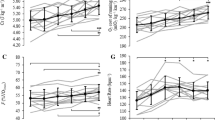Abstract
The energy cost of kayaking per unit distance (Ck, kJ · m−1) was assessed in eight middle- to high-class athletes (three males and five females; 45–76 kg body mass; 1.50–1.88 m height; 15–32 years of age) at submaximal and maximal speeds. At submaximal speeds, Ck was measured by dividing the steady-state oxygen consumption (V˙O2, l · s−1) by the speed (v, m · s−1), assuming an energy equivalent of 20.9 kJ · l O−1 2. At maximal speeds, Ck was calculated from the ratio of the total metabolic energy expenditure (E, kJ) to the distance (d, m). E was assumed to be the sum of three terms, as originally proposed by Wilkie (1980): E = AnS + αV˙O2max · t−αV˙O2max · τ(1−e −t·τ−1), were α is the energy equivalent of O2 (20.9 kJ · l O2 −1), τ is the time constant with which V˙O2max is attained at the onset of exercise at the muscular level, AnS is the amount of energy derived from anaerobic energy utilization, t is the performance time, and V˙O2max is the net maximal V˙O2. Individual V˙O2max was obtained from the V˙O2 measured during the last minute of the 1000-m or 2000-m maximal run. The average metabolic power output (E˙, kW) amounted to 141% and 102% of the individual maximal aerobic power (V˙O2max) from the shortest (250 m) to the longest (2000 m) distance, respectively. The average (SD) power provided by oxidative processes increased with the distance covered [from 0.64 (0.14) kW at 250 m to 1.02 (0.31) kW at 2000 m], whereas that provided by anaerobic sources showed the opposite trend. The net Ck was a continuous power function of the speed over the entire range of velocities from 2.88 to 4.45 m · s−1: C k = 0.02 · v 2.26 (r = 0.937, n = 32).
Similar content being viewed by others
Author information
Authors and Affiliations
Additional information
Accepted: 17 May 1999
Rights and permissions
About this article
Cite this article
Zamparo, P., Capelli, C. & Guerrini, G. Energetics of kayaking at submaximal and maximal speeds. Eur J Appl Physiol 80, 542–548 (1999). https://doi.org/10.1007/s004210050632
Issue Date:
DOI: https://doi.org/10.1007/s004210050632




